Answered step by step
Verified Expert Solution
Question
1 Approved Answer
Subway's business model was predicated on the franchise system; by 2020, every single restaurant was franchised-Subway owned none of its stores. DeLuca believed that
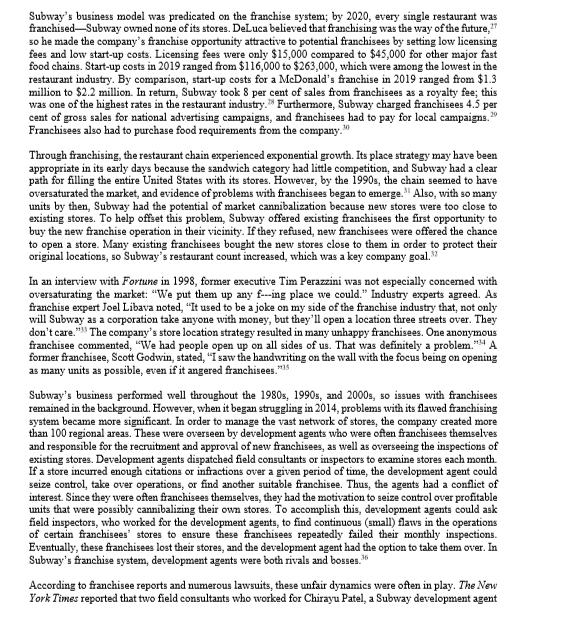
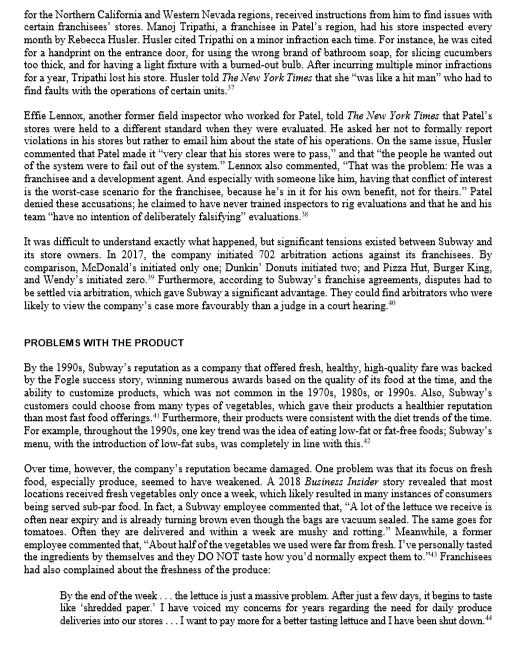
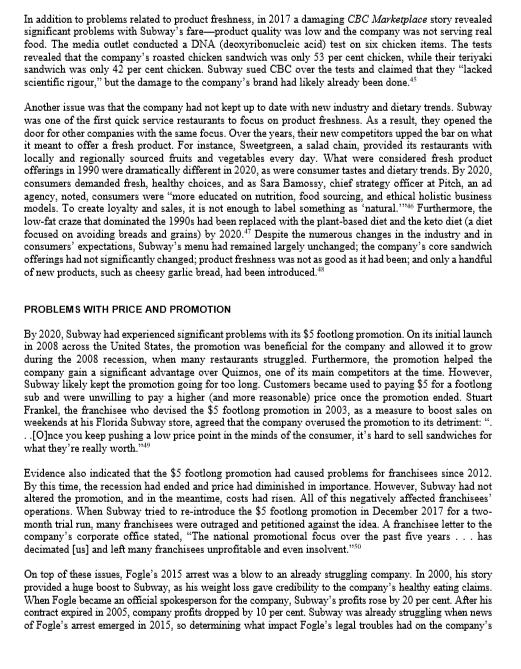

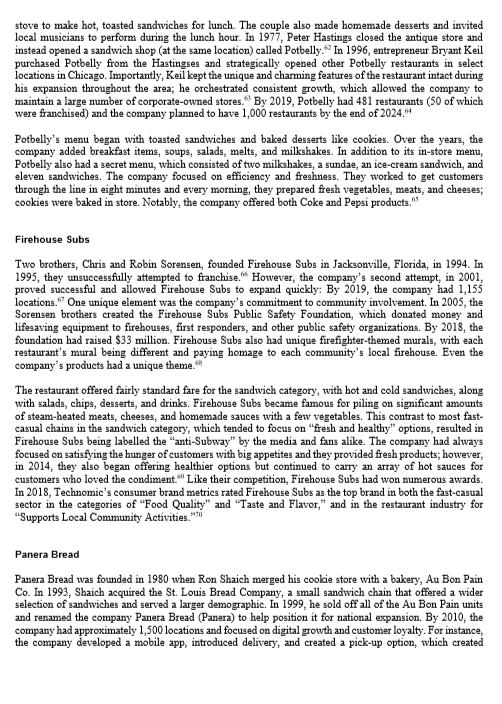
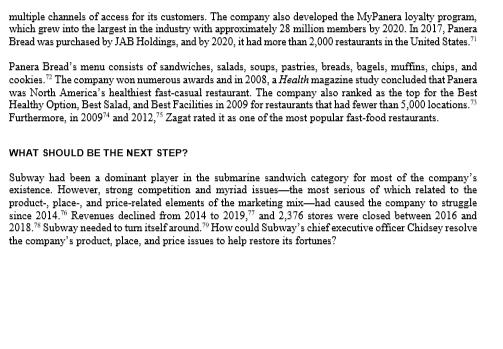
Subway's business model was predicated on the franchise system; by 2020, every single restaurant was franchised-Subway owned none of its stores. DeLuca believed that franchising was the way of the future," so he made the company's franchise opportunity attractive to potential franchisees by setting low licensing fees and low start-up costs. Licensing fees were only $15,000 compared to $45,000 for other major fast food chains. Start-up costs in 2019 ranged from $116,000 to $263,000, which were among the lowest in the restaurant industry. By comparison, start-up costs for a McDonald's franchise in 2019 ranged from $1.3 million to $2.2 million. In return, Subway took 8 per cent of sales from franchisees as a royalty fee; this was one of the highest rates in the restaurant industry. Furthermore, Subway charged franchisees 4.5 per cent of gross sales for national advertising campaigns, and franchisees had to pay for local campaigns.20 Franchisees also had to purchase food requirements from the company." Through franchising, the restaurant chain experienced exponential growth. Its place strategy may have been appropriate in its early days because the sandwich category had little competition, and Subway had a clear path for filling the entire United States with its stores. However, by the 1990s, the chain seemed to have oversaturated the market, and evidence of problems with franchisees began to emerge." Also, with so many units by then, Subway had the potential of market cannibalization because new stores were too close to existing stores. To help offset this problem, Subway offered existing franchisees the first opportunity to buy the new franchise operation in their vicinity. If they refused, new franchisees were offered the chance to open a store. Many existing franchisees bought the new stores close to them in order to protect their original locations, so Subway's restaurant count increased, which was a key company goal." In an interview with Fortune in 1998, former executive Tim Perazzini was not especially concerned with oversaturating the market: "We put them up any f---ing place we could." Industry experts agreed. As franchise expert Joel Libava noted, "It used to be a joke on my side of the franchise industry that, not only will Subway as a corporation take anyone with money, but they'll open a location three streets over. They don't care." The company's store location strategy resulted in many unhappy franchisees. One anonymous franchisee commented, "We had people open up on all sides of us. That was definitely a problem." A former franchisee, Scott Godwin, stated, "I saw the handwriting on the wall with the focus being on opening as many units as possible, even if it angered franchisees." Subway's business performed well throughout the 1980s, 1990s, and 2000s, so issues with franchisees remained in the background. However, when it began struggling in 2014, problems with its flawed franchising system became more significant. In order to manage the vast network of stores, the company created more than 100 regional areas. These were overseen by development agents who were often franchisees themselves and responsible for the recruitment and approval of new franchisees, as well as overseeing the inspections of existing stores. Development agents dispatched field consultants or inspectors to examine stores each month. If a store incurred enough citations or infractions over a given period of time, the development agent could seize control, take over operations, or find another suitable franchisee. Thus, the agents had a conflict of interest. Since they were often franchisees themselves, they had the motivation to seize control over profitable units that were possibly cannibalizing their own stores. To accomplish this, development agents could ask field inspectors, who worked for the development agents, to find continuous (small) flaws in the operations of certain franchisees' stores to ensure these franchisees repeatedly failed their monthly inspections. Eventually, these franchisees lost their stores, and the development agent had the option to take them over. In Subway's franchise system, development agents were both rivals and bosses.36 According to franchisee reports and numerous lawsuits, these unfair dynamics were often in play. The New York Times reported that two field consultants who worked for Chirayu Patel, a Subway development agent for the Northern California and Western Nevada regions, received instructions from him to find issues with certain franchisees' stores. Manoj Tripathi, a franchisee in Patel's region, had his store inspected every month by Rebecca Husler. Husler cited Tripathi on a minor infraction each time. For instance, he was cited for a handprint on the entrance door, for using the wrong brand of bathroom soap, for slicing cucumbers too thick, and for having a light fixture with a burned-out bulb. After incurring multiple minor infractions for a year, Tripathi lost his store. Husler told The New York Times that she was like a hit man" who had to find faults with the operations of certain units." Effie Lennox, another former field inspector who worked for Patel, told The New York Times that Patel's stores were held to a different standard when they were evaluated. He asked her not to formally report violations in his stores but rather to email him about the state of his operations. On the same issue, Husler commented that Patel made it "very clear that his stores were to pass," and that "the people he wanted out of the system were to fail out of the system." Lennox also commented, "That was the problem: He was a franchisee and a development agent. And especially with someone like him, having that conflict of interest is the worst-case scenario for the franchisee, because he's in it for his own benefit, not for theirs." Patel denied these accusations; he claimed to have never trained inspectors to rig evaluations and that he and his team "have no intention of deliberately falsifying" evaluations." It was difficult to understand exactly what happened, but significant tensions existed between Subway and its store owners. In 2017, the company initiated 702 arbitration actions against its franchisees. By comparison, McDonald's initiated only one; Dunkin' Donuts initiated two; and Pizza Hut, Burger King, and Wendy's initiated zero." Furthermore, according to Subway's franchise agreements, disputes had to be settled via arbitration, which gave Subway a significant advantage. They could find arbitrators who were likely to view the company's case more favourably than a judge in a court hearing. PROBLEMS WITH THE PRODUCT By the 1990s, Subway's reputation as a company that offered fresh, healthy, high-quality fare was backed by the Fogle success story, winning numerous awards based on the quality of its food at the time, and the ability to customize products, which was not common in the 1970s, 1980s, or 1990s. Also, Subway's customers could choose from many types of vegetables, which gave their products a healthier reputation than most fast food offerings. Furthermore, their products were consistent with the diet trends of the time. For example, throughout the 1990s, one key trend was the idea of eating low-fat or fat-free foods; Subway's menu, with the introduction of low-fat subs, was completely in line with this." Over time, however, the company's reputation became damaged. One problem was that its focus on fresh food, especially produce, seemed to have weakened. A 2018 Business Insider story revealed that most locations received fresh vegetables only once a week, which likely resulted in many instances of consumers being served sub-par food. In fact, a Subway employee commented that, "A lot of the lettuce we receive is often near expiry and is already turning brown even though the bags are vacuum sealed. The same goes for tomatoes. Often they are delivered and within a week are mushy and rotting." Meanwhile, a former employee commented that, "About half of the vegetables we used were far from fresh. I've personally tasted the ingredients by themselves and they DO NOT taste how you'd normally expect them to."43 Franchisees had also complained about the freshness of the produce: By the end of the week... the lettuce is just a massive problem. After just a few days, it begins to taste like 'shredded paper. I have voiced my concerns for years regarding the need for daily produce deliveries into our stores... I want to pay more for a better tasting lettuce and I have been shut down." In addition to problems related to product freshness, in 2017 a damaging CBC Marketplace story revealed significant problems with Subway's fare-product quality was low and the company was not serving real food. The media outlet conducted a DNA (deoxyribonucleic acid) test on six chicken items. The tests revealed that the company's roasted chicken sandwich was only 53 per cent chicken, while their teriyaki sandwich was only 42 per cent chicken. Subway sued CBC over the tests and claimed that they "lacked scientific rigour," but the damage to the company's brand had likely already been done.** Another issue was that the company had not kept up to date with new industry and dietary trends. Subway was one of the first quick service restaurants to focus on product freshness. As a result, they opened the door for other companies with the same focus. Over the years, their new competitors upped the bar on what it meant to offer a fresh product. For instance, Sweetgreen, a salad chain, provided its restaurants with locally and regionally sourced fruits and vegetables every day. What were considered fresh product offerings in 1990 were dramatically different in 2020, as were consumer tastes and dietary trends. By 2020, consumers demanded fresh, healthy choices, and as Sara Bamossy, chief strategy officer at Pitch, an ad agency, noted, consumers were "more educated on nutrition, food sourcing, and ethical holistic business models. To create loyalty and sales, it is not enough to label something as 'natural. Furthermore, the low-fat craze that dominated the 1990s had been replaced with the plant-based diet and the keto diet (a diet focused on avoiding breads and grains) by 2020. Despite the numerous changes in the industry and in consumers' expectations, Subway's menu had remained largely unchanged; the company's core sandwich offerings had not significantly changed; product freshness was not as good as it had been; and only a handful of new products, such as cheesy garlic bread, had been introduced. PROBLEMS WITH PRICE AND PROMOTION By 2020, Subway had experienced significant problems with its $5 footlong promotion. On its initial launch in 2008 across the United States, the promotion was beneficial for the company and allowed it to grow during the 2008 recession, when many restaurants struggled. Furthermore, the promotion helped the company gain a significant advantage over Quiznos, one of its main competitors at the time. However, Subway likely kept the promotion going for too long. Customers became used to paying $5 for a footlong sub and were unwilling to pay a higher (and more reasonable) price once the promotion ended. Stuart Frankel, the franchisee who devised the $5 footlong promotion in 2003, as a measure to boost sales on weekends at his Florida Subway store, agreed that the company overused the promotion to its detriment: ". ..[O]nce you keep pushing a low price point in the minds of the consumer, it's hard to sell sandwiches for what they're really worth. Evidence also indicated that the $5 footlong promotion had caused problems for franchisees since 2012. By this time, the recession had ended and price had diminished in importance. However, Subway had not altered the promotion, and in the meantime, costs had risen. All of this negatively affected franchisees' operations. When Subway tried to re-introduce the $5 footlong promotion in December 2017 for a two- month trial run, many franchisees were outraged and petitioned against the idea. A franchisee letter to the company's corporate office stated, "The national promotional focus over the past five years... has decimated [us] and left many franchisees unprofitable and even insolvent."50 On top of these issues, Fogle's 2015 arrest was a blow to an already struggling company. In 2000, his story provided a huge boost to Subway, as his weight loss gave credibility to the company's healthy eating claims. When Fogle became an official spokesperson for the company, Subway's profits rose by 20 per cent. After his contract expired in 2005, company profits dropped by 10 per cent. Subway was already struggling when news of Fogle's arrest emerged in 2015, so determining what impact Fogle's legal troubles had on the company's bottom line was difficult, if not impossible. No doubt, this incident had a significantly negative impact on the corporation, even though the company publicly cut ties with him immediately following his arrest. COMPETITION The sandwich category of the restaurant industry had little competition when Subway entered that market, and those that were in the market tended to be small. The company's main competitor, Quiznos, specialized in toasted subs, so Subway added toasters to its kitchens and priced its footlong subs at $5. Stripped of its competitive advantage and not being able to compete with Subway on price, Quiznos experienced a sharp decline and eventually faced bankruptcy. However, by 2020, Subway faced strong competition from sandwich shops whose operations had grown considerably since 2008; these included Jimmy John's, Jersey Mike's, Firehouse Subs, Potbelly, and Panera Bread." Jimmy John's Jimmy John's was founded by Jimmy John Liautaud in Charleston, Illinois, in 1983. The company grew slowly at first with only 10 stores by 1994. However, between 1994 and 2002, Jimmy John's grew more rapidly from having just 10 locations to 160, with most of them being franchised. While the company had grown, many locations were still struggling, so Jimmy John's suspended franchising for one year in an attempt to turn around stores that were having difficulties. Seventy underperforming stores were visited, and franchisee standards were reformulated, which also raised the standards for future business." Since 2003, Jimmy John's continued to grow quickly, and by 2017, the company had 2,840 stores." The restaurant offered a variety of sandwiches (8-inch and 16-inch), chips, cookies, and drinks-a menu similar to that of Subway." To deliver a high-quality product to its customers, Jimmy John's had always used all- natural meats; fresh, local produce; bread that was baked in-store daily; and, the best quality condiments.56 The company had won a number of awards and had the highest brand loyalty among millennials." In 2016, it was named the top franchise in Entrepreneur's Franchise 500. Jersey Mike's Jersey Mike's was founded in 1956 in Point Pleasant, New Jersey, as Mike's Subs. In 1975, Mike's Subs was sold to Peter Cancro, a 17-year-old employee of Mike's Subs. Shortly after purchasing the business, Cancro opened a few more locations, and in 1987, he changed the company's name to Jersey Mike's and began franchising. The company struggled initially and lost $2 million during the 1991 recession. Growth resumed in 1994 and franchising continued to be successful. By 2019, Jersey Mike's had 1,551 stores, mostly in the United States, and plans to open 500 more by the end of 2020. The company offered a variety of hot and cold sandwiches, wraps, chips, cookies, and drinks and had always focused on providing high-quality products to its customers. To differentiate itself from its competitors, the company used red wine vinegar and an olive oil blend to create a unique taste. Only the leanest and tastiest meats were used, in addition to well-aged cheese. Produce was locally grown and packed, and bread (white and whole wheat) was made in-store every day." Potbelly Potbelly originated as an antique shop in 1971 in Chicago, Illinois, owned and operated by Peter Hastings and his wife. On a whim, the couple decided to serve sandwiches to their customers and used an old potbelly stove to make hot, toasted sandwiches for lunch. The couple also made homemade desserts and invited local musicians to perform during the lunch hour. In 1977, Peter Hastings closed the antique store and instead opened a sandwich shop (at the same location) called Potbelly. In 1996, entrepreneur Bryant Keil purchased Potbelly from the Hastingses and strategically opened other Potbelly restaurants in select locations in Chicago. Importantly, Keil kept the unique and charming features of the restaurant intact during his expansion throughout the area; he orchestrated consistent growth, which allowed the company to maintain a large number of corporate-owned stores. By 2019, Potbelly had 481 restaurants (50 of which were franchised) and the company planned to have 1,000 restaurants by the end of 2024.04 Potbelly's menu began with toasted sandwiches and baked desserts like cookies. Over the years, the company added breakfast items, soups, salads, melts, and milkshakes. In addition to its in-store menu, Potbelly also had a secret menu, which consisted of two milkshakes, a sundae, an ice-cream sandwich, and eleven sandwiches. The company focused on efficiency and freshness. They worked to get customers through the line in eight minutes and every morning, they prepared fresh vegetables, meats, and cheeses; cookies were baked in store. Notably, the company offered both Coke and Pepsi products."* Firehouse Subs Two brothers, Chris and Robin Sorensen, founded Firehouse Subs in Jacksonville, Florida, 1994. In 1995, they unsuccessfully attempted to franchise." However, the company's second attempt, in 2001, proved successful and allowed Firehouse Subs to expand quickly: By 2019, the company had 1,155 locations. One unique element was the company's commitment to community involvement. In 2005, the Sorensen brothers created the Firehouse Subs Public Safety Foundation, which donated money and lifesaving equipment to firehouses, first responders, and other public safety organizations. By 2018, the foundation had raised $33 million. Firehouse Subs also had unique firefighter-themed murals, with each restaurant's mural being different and paying homage to each community's local firehouse. Even the company's products had a unique theme." The restaurant offered fairly standard fare for the sandwich category, with hot and cold sandwiches, along with salads, chips, desserts, and drinks. Firehouse Subs became famous for piling on significant amounts of steam-heated meats, cheeses, and homemade sauces with a few vegetables. This contrast to most fast- casual chains in the sandwich category, which tended to focus on "fresh and healthy" options, resulted in Firehouse Subs being labelled the "anti-Subway" by the media and fans alike. The company had always focused on satisfying the hunger of customers with big appetites and they provided fresh products; however, in 2014, they also began offering healthier options but continued to carry an array of hot sauces for customers who loved the condiment." Like their competition, Firehouse Subs had won numerous awards. In 2018, Technomic's consumer brand metrics rated Firehouse Subs as the top brand in both the fast-casual sector in the categories of "Food Quality" and "Taste and Flavor," and in the restaurant industry for "Supports Local Community Activities." Panera Bread Panera Bread was founded in 1980 when Ron Shaich merged his cookie store with a bakery, Au Bon Pain Co. In 1993, Shaich acquired the St. Louis Bread Company, a small sandwich chain that offered a wider selection of sandwiches and served a larger demographic. In 1999, he sold off all of the Au Bon Pain units and renamed the company Panera Bread (Panera) to help position it for national expansion. By 2010, the company had approximately 1,500 locations and focused on digital growth and customer loyalty. For instance, the company developed a mobile app, introduced delivery, and created a pick-up option, which created multiple channels of access for its customers. The company also developed the MyPanera loyalty program, which grew into the largest in the industry with approximately 28 million members by 2020. In 2017, Panera Bread was purchased by JAB Holdings, and by 2020, it had more than 2,000 restaurants in the United States." Panera Bread's menu consists of sandwiches, salads, soups, pastries, breads, bagels, muffins, chips, and cookies. The company won numerous awards and in 2008, a Health magazine study concluded that Panera was North America's healthiest fast-casual restaurant. The company also ranked as the top for the Best Healthy Option, Best Salad, and Best Facilities in 2009 for restaurants that had fewer than 5,000 locations." Furthermore, in 2009 and 2012,75 Zagat rated it as one of the most popular fast-food restaurants. WHAT SHOULD BE THE NEXT STEP? Subway had been a dominant player in the submarine sandwich category for most of the company's existence. However, strong competition and myriad issues-the most serious of which related to the product-, place, and price-related elements of the marketing mix-had caused the company to struggle since 2014. Revenues declined from 2014 to 2019," and 2,376 stores were closed between 2016 and 2018. Subway needed to turn itself around." How could Subway's chief executive officer Chidsey resolve the company's product, place, and price issues to help restore its fortunes?
Step by Step Solution
★★★★★
3.46 Rating (156 Votes )
There are 3 Steps involved in it
Step: 1
1Subway cafs declining deals public connection issues and so forth throughout the course of recent yearsaIssues with Pricing Subway has taken on diffe...
Get Instant Access to Expert-Tailored Solutions
See step-by-step solutions with expert insights and AI powered tools for academic success
Step: 2

Step: 3

Ace Your Homework with AI
Get the answers you need in no time with our AI-driven, step-by-step assistance
Get Started


